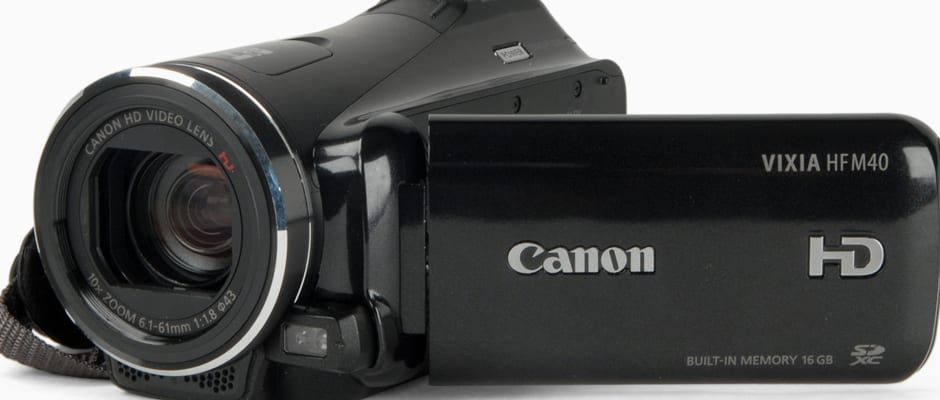Pros
Cons
Introduction
Front
{{section_header}}{{section.name}}{{/section_header}}

Back
{{section_header}}{{section.name}}{{/section_header}}

Left
{{section_header}}{{section.name}}{{/section_header}}
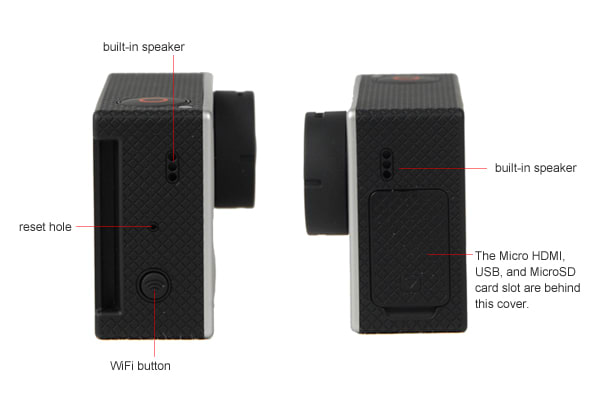
Right
{{section_header}}{{section.name}}{{/section_header}}
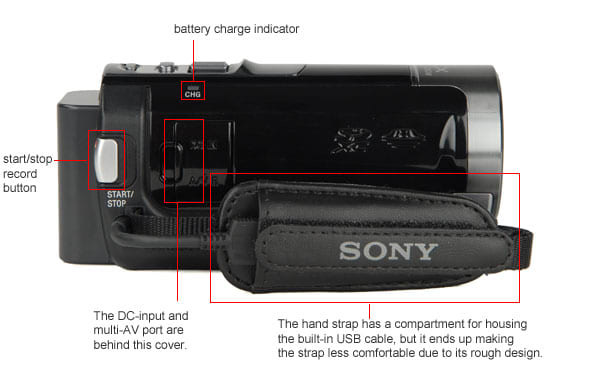
Top
{{section_header}}{{section.name}}{{/section_header}}

Bottom
{{section_header}}{{section.name}}{{/section_header}}

In the Box
{{section_header}}{{section.name}}{{/section_header}}

- Canon Vixia HF M40 camcorder
- rechargeable lithium-ion battery pack (BP-808)
- DC power adapter and power cord
- HDMI cable
- composite AV cable
- USB cable
- wireless remote control (WL-D89)
- stylus pen
- Quick Guide
- installation guide for PIXELA'S software
We definitely approve of the addition of the included HDMI cable and the slimming down of included software. All those discs and packaging were always so wasteful!
Color
{{section_header}}{{section.name}}{{/section_header}}
The Canon Vixia HF M40 performed extremely well in our color tests, with very accurate colors and impressive saturation. Since this is a mid-range consumer camcorder, we expected to find unnaturally vivid colors (an aesthetic that many consumers enjoy). Instead, we found a nearly perfect amount of saturation, with colors that look very close to what we see in real life. Green hues were the most troublesome part of the spectrum for the M40. More on how we test color.
Color Error Map The map above is a diagram of the color error. The length and direction of each line indicates how the camera processed each particular color while capturing video.
The Canon Vixia HF M40 produced a color error of 3.31 and a saturation level of 91.39% in our bright light color testing.
The HF M40 does not offer any color modes outside of its scene mode and Cinema mode selections, but it does offer the user some minor control over color depth, contrast, sharpness, and brightness. These controls are located in the Image Effects submenu within the main Function menu. For purposes of comparison, we filmed our train setting using different color and contrast options. We found that the impact of these settings is quite minor, even when set to a maximum of +2 or a minimum of -2.
If you want a slightly more automated experience, Cinema mode offers filters like Vivid, Dream, Cool, and Nostalgic. (See Other Controls.)
Color Modes
Auto
100% Crop
Contrast-2
100% Crop
At a glance, you'll see that most of the stills grabbed from our bright light color testing look very similar. There's not a huge difference between camcorders in this price range. The Panasonic TM90 is quite a bit more vivid than the others—an excellent quality if you like super saturated photos, but not if you strive for color accuracy. You can also see that the HF M40 is an improvement over the somewhat duller HF M31 from 2010.
Most camcorders in this price range do an adequate job of producing accurate colors, though the Canon HF M40 is definitely the best of our comparison group. Canon did an excellent job of improving upon the inaccuracies of yellow and pink hues in last year's HF M31. The M40 also bested the 2011 Panasonic HDC-TM90, which had very good color performance, and the less impressive Sony HDR-XR350V.
{{comparison_bars title="Color Score Comparison", attribute="Color Score", xLabel="Color Score"}}
Low Light Color
{{section_header}}{{section.name}}{{/section_header}}
Unsurprisingly, the boost in sensitivity also helped maintain color accuracy in low light. With brighter footage overall, colors were less washed out than we typically see in consumer camcorders. Of course, color performance is still not as good as what you might get in bright light: the average color accuracy is 4.6 and saturation is just 68.73%. Those are still excellent numbers for a camcorder in this class. More on how we test low light color.
Color Error Map The map on the left is a diagram of the color error. The length and direction of each line indicates how the camera processed each particular color while capturing video.
The Canon Vixia HF M40 produced a color error of and a saturation level of in our bright light color testing.
Color accuracy in the HF M40's alternate frame rates was boosted slightly, largely owing to the increase in brightness at these frame rates. Color accuracy in the PF30 mode was improved to 3.77, with a saturation of 78.47%. The PF24 mode demonstrated a color accuracy of 3.74, with a saturation of 83.77%. The boost isn't as large as we've seen from previous camcorders—perhaps because the HF M40's low light performance is already so good.
Of the camcorders listed in this comparison group, the Canon HF M40 again takes the cake in low light performance. Its color accuracy is a significant improvement over what the other models offer.
Noise
{{section_header}}{{section.name}}{{/section_header}}
The HF M40 turned in impressive scores for noise, with an average of just 0.75% noise in our bright light testing. That's very good, considering how sharp the footage is. (We tend to find that camcorders with high sharpness pick up every single detail—noise included.) Of course, to the naked eye, none of these camcorders exhibit much noise in bright light. More on how we test noise.
Canon Vixia HF M40 100% Crop
While boosting the megapixels on your sensor does seem to improve apparent sharpness, it also introduces plenty of unwelcome noise. So, it comes as no surprise that the best performing camcorder for noise in this comparison group was the Sony XR350—also the worst camcorder for video sharpness. And it's to be expected that the lower sensor resolution of the HF M40 improved noise performance; the HF M31's 3.89-megapixel sensor did not turn in very good noise scores last year.
{{comparison_bars title="Noise Score Comparison", attribute="Noise Score", xLabel="Noise Score"}}
Low Light Sensitivity
{{section_header}}{{section.name}}{{/section_header}}
Quite frankly, we were blown away by the impressive performance of the Canon HF M40 in our low light video testing. Canon's decision to lower the pixel count on its 2011 sensors turns out to be a wise one: sharpness is only slightly lowered, while low light performance took a huge leap forward. The M40 required just 5 lux of light in order to output 50IRE: a performance that has only been rivaled by its step-up model, the HF G10. More on how we test low light sensitivity.
Using the camcorder's alternate frame rates, we were able to boost sensitivity even further, reaching 50IRE with just 1-3 lux at 24p and 30p. We also looked at the M40's sensitivity when zoomed all the way out to reach the camera's widest aperture. At 60i, this resulted in a 50IRE output at just 3 lux. Competing camcorders required 12-30lux to match the Canon's performance.
This all adds up to the best low light sensitivity we've seen from virtually any camcorder we've ever tested. If you plan to do a lot of shooting in dim conditions, these new Vixia camcorders are the perfect companion.
{{comparison_bars title="Low Light Sensitivity Comparison", attribute="Low Light Sensitivity Score", xLabel="Low Light Sensitivity Score"}}
Low Light Noise
{{section_header}}{{section.name}}{{/section_header}}
The Canon HF M40 actually fared very well in our low light noise testing—likely another result of the sensor's increased sensitivity. With consumer camcorders that typically increase gain automatically, noise is a common guest at the low light party. (Gain increases brightness, but also increases noise.) The HF M40 allows you to turn off gain through the manual AGC Limit control, but even with the gain set to auto, we found the footage had very little noise: just 0.93%. More on how we test low light noise.
Canon Vixia HF M40 100% Crop
The PF30 and PF24 frame rates brightened footage and, therefore, decreased noise. As was the case at 60i, the brighter your footage, the less gain is required to achieve adequate results. Less gain means less noise. In the case of these alternate frame rates, the decrease in noise is very minor, while the altered aesthetic of 30p or 24p footage is noticeable.
The killer low light sensor on the Canon HF M40 killed the competition in our low light noise testing. The closest competition we found was the Sony HDR-XR350V, which performed well in our bright light noise testing as well. (The Sony's sensor is relatively low resolution and tended to smear out most noise.) The combination of bright footage and low noise makes the HF M40 a very compelling choice for shooting indoors or in dim lighting.
{{comparison_bars title="Low Light Noise Score Comparison", attribute="Low Light Noise Score", xLabel="Low Light Noise Score"}}
Low Light Color
{{section_header}}{{section.name}}{{/section_header}}
Unsurprisingly, the boost in sensitivity also helped maintain color accuracy in low light. With brighter footage overall, colors were less washed out than we typically see in consumer camcorders. Of course, color performance is still not as good as what you might get in bright light: the average color accuracy is 4.6 and saturation is just 68.73%. Those are still excellent numbers for a camcorder in this class. More on how we test low light color.
Low Light Color Accuracy Performance
Color Error Map The map on the left is a diagram of the color error. The length and direction of each line indicates how the camera processed each particular color while capturing video.
The Canon Vixia HF M40 produced a color error of and a saturation level of in our bright light color testing.
Color accuracy in the HF M40's alternate frame rates was boosted slightly, largely owing to the increase in brightness at these frame rates. Color accuracy in the PF30 mode was improved to 3.77, with a saturation of 78.47%. The PF24 mode demonstrated a color accuracy of 3.74, with a saturation of 83.77%. The boost isn't as large as we've seen from previous camcorders—perhaps because the HF M40's low light performance is already so good.
Of the camcorders listed in this comparison group, the Canon HF M40 again takes the cake in low light performance. Its color accuracy is a significant improvement over what the other models offer.
Motion
{{section_header}}{{section.name}}{{/section_header}}
Canon is using the same Digic DV III processor from last year's lineup, but has thrown a totally different sensor and lens combo into the mix for the Vixia HF M40. The new sensor did seem to take a bit away from sharpness, but the video looked excellent otherwise, making it hard to tell the difference between video recorded with the M40 and video recorded with the more expensive flagship model, the Canon HF G10.
The default recording option is 1920 x 1080 at 60i—a setting that looked very good in a variety of lighting conditions. For some added versatility, you can record at the 60i frame rate, then output video at an alternate frame rate of 30p or 24p. These PF30 and PF24 options aren't native frame rates, but they achieve the effect well enough to satisfy most consumers. The HF M40 does not have a native 24p record mode like the HF G10; it's also lacking the 60p frame rate option that you'll find on the Panasonic TM90. More on how we test motion.
Video Sharpness
{{section_header}}{{section.name}}{{/section_header}}
Canon's choice to decrease the pixel count on the 2011 sensors definitely impacted video sharpness, though the decrease in sharpness is not nearly as drastic as we expected. Horizontal sharpness of the HF M40 came in around 850 lw/ph, while vertical sharpness was 600 lw/ph.
Those are the same results we saw on the Canon HF G10 reviewed earlier this year. That represents only a minor decrease in sharpness from last year's models—evidence, in our minds, that Canon's decision was a wise one. The decrease in sharpness is only minor, but the improvement to low light performance is significant. More on how we test video sharpness.
{{comparison_bars title="Video Sharpness Score Comparison", attribute="Video Sharpness Score", xLabel="Video Sharpness Score"}}
Stabilization
{{section_header}}{{section.name}}{{/section_header}}
The Canon HF M40 has multiple stabilization options, all of which center around the camcorder's optical image stabilization system (OIS). While the camcorder didn't do quite as well as the Panasonic HDC-TM90 or the Sony HDR-XR350V in this test, it did do much better than last year's HF M31. We found the HF M40's best stabilization results came when we used the Powered IS option that is activated by a button on the LCD panel. More on how we test stabilization.
The regular OIS on the HF M40 worked decently, reducing 46% of the shake in our low shake test. In our high shake test, the regular OIS wasn't as solid, reducing roughly 38% of the shake. Activating the Powered IS feature on the HF M40 increased results dramatically: 53% shake reduction in the low shake test and 67% reduction in our high shake test. The camcorder's third stabilization option, active mode, was the worst of the three. It reduced shake by 21% in our low shake test and by 39% in our high shake test.
Ease of Use
{{section_header}}{{section.name}}{{/section_header}}
The Canon HF M40 is relatively easy to use, though the sheer volume of options may intimidate first-time camcorder owners. A switch on the right allows users to activate a full Auto mode, which turns off nearly every other option in the camcorder. Some other auto modes are described in the Auto Mode section.
There are also two nifty little features that Canon has added in order to create a more accessible user experience: Video Snap and Story Creator. We describe both options in the Other Features section of this review. We've never found Video Snap to be particularly enticing, but we really like the Story Creator mode that Canon introduced this year.
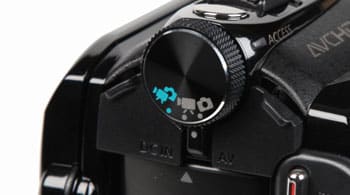
Auto Mode is confusingly called Dual Shot mode
If you aren't planning to take advantage of the various cruise control options, you'll probably spend a lot more time navigating among the camcorder's menus. Although Canon continues to employ a slick graphical interface, the menus are still packed with features and very daunting for beginners. Many of these features are not very well described and there's no built-in tooltip or help system to aid in deciphering these menus.
The best tool for advanced users is probably the instruction manual, which is thorough and quite helpful.
Auto Mode
{{section_header}}{{section.name}}{{/section_header}}
The Canon HF M40 offers the user tons of different options for a simpler automated experience. While we appreciate the many efforts Canon is making to ease the way for beginning users, there are times when we felt there were too many auto options. Essentially, you can shoot in full auto, program auto, scene mode, or Cinema Mode. Those can be combined with Video Snap or Story Creator. If that sounds confusing, we don't blame you.
The mode switch on the right side of the camcorder allows you to choose between Manual, Cinema, and Auto modes. This Auto mode is the only true auto mode on the camcorder: it will lock you out of all options except for zoom and decorations. As a full cruise control experience, this pretty much fits the bill. You can start and stop recording at your leisure and you won't be bothered by all those pesky options.
If you want a bit more control than Auto mode offers, you can keep the camcorder switched to Manual, then choose Scene Mode from the function menu. This gives you access to a handful of programmed scenarios—a list of options that Canon has expanded since last year. You'll still be able to do a manual focus or tweak exposure compensation, but the HF M40 will lock you out of white balance, gain, and image effects.
Cinema mode (see Other Controls) applies a digital filter to your footage, while giving you access to every control except for image effects. Programmed AE is the most versatile auto mode, giving you full access to all controls except for aperture and shutter speed.
Every mode can be used in conjunction with Video Snap or Story Creator (see Other Features).
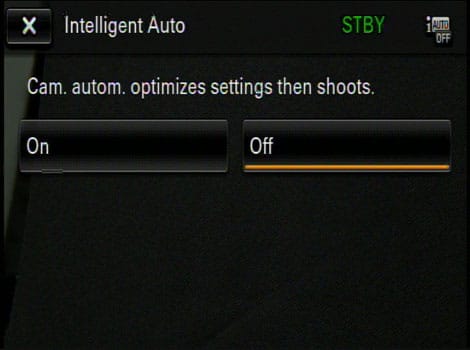
The iAuto mode button is difficult to find, but when you do find it the option for turning on the mode looks like this.
Auto Controls
{{section_header}}{{section.name}}{{/section_header}}
When it comes to automatic controls, the HF M40 performed quickly and accurately in most shooting scenarios. Auto exposure was sometimes very abrupt when moving from light to dark scenes, but we saw this on last year's Canon models as well. AF/AE tracking returns this year and seems to work adequately, with the occasional loss of subject.
You'll have to use the LCD touchscreen for everything, but we certainly don't miss the clunky control dial from the HF G10. As with most touchscreen camcorders, we don't like that your finger gets in the way when you're making image adjustments, but touchscreens are becoming more and more pervasive, especially on entry-level and mid-range models.
As for the extras, Canon provides optional features for face detection, backlight correction, auto slow shutter, and tele macro zoom.
Handling
{{section_header}}{{section.name}}{{/section_header}}
The HF M40 is a more compact camcorder than Canon's hefty flagship, the HF G10. We found that it fits comfortably in most hands, with a reasonably comfortable hand strap and contoured surfaces. If you're using the accessory shoe, you might have trouble finding a spot to rest your pinkie, but that's become virtually status quo for consumer camcorders these days.

For one-handed operation, the zoom toggle and record button rest comfortably within reach, but you won't find any other buttons or features intended to be operated with the right hand. The rest of the camcorder's controls are accessed via touch screen or nestled within the LCD cavity. We regret the absence of the excellent focus ring from Canon's step-up model, but we don't miss the awkward control dial.

As for the touchscreen itself, we found it to be no more or less finicky than any other camcorder or camera touchscreen we've used. There was a definite lag in responsiveness and there were times when we tapped several times in frustration before a menu option was activated. Using the stylus (or fingernail) was definitely the most accurate and efficient method to interact with the touchscreen.


These dedicated buttons give you quick access to aperture and shutter speed controls.
Portability
{{section_header}}{{section.name}}{{/section_header}}
The Canon HF M40 is definitely a shade larger than last year's HF M30 and HF M31. We feel that the additional size makes for a more comfortable contour; the HF M40 is about as small as we'd like a camcorder to be if we're going to be holding it for an extended period of time. Both the size and weight are still considerably smaller than what you'll get from the HF G10.
The dual card slots and internal memory make the HF M40 incredibly appealing for travelers, with numerous options for storing, copying, and transferring your files. In a pinch, you can use relay record to automatically spill over onto a card when your internal memory is full. Plus, you can use the camera's built-in HD-to-SD downconversion if you're really tight on space.
The battery cavity is quite deep, so you can purchase additional batteries with twice the capacity and not have to worry about some clunky thing sticking out the back of your camcorder. The battery can be charged via a standard AC/DC power cable, or you can run the camera straight from the wall outlet. Standard connections for USB, AV, and HDMI mean that you won't need to run around looking for proprietary cables if you lose the ones that came with your camcorder.
Battery Life
{{section_header}}{{section.name}}{{/section_header}}
The HF M40 ships with the BP-808 rechargeable lithium-ion battery pack. The pack itself lasted for approximately 125 minutes—excellent performance for such a small battery. More on how we test battery life.
We love that the M40's battery cavity is so deep, allowing you to upgrade to a much larger battery without the annoyance of having your pack jut out from the back of the camcorder. The battery can be easily recharged by plugging the camcorder into a wall adapter. Since you can run the camcorder directly off the power cable, you can easily swap batteries without interrupting your recording.

Stabilization
{{section_header}}{{section.name}}{{/section_header}}
The Canon HF M40 has multiple stabilization options, all of which center around the camcorder's optical image stabilization system (OIS). While the camcorder didn't do quite as well as the Panasonic HDC-TM90 or the Sony HDR-XR350V in this test, it did do much better than last year's HF M31. We found the HF M40's best stabilization results came when we used the Powered IS option that is activated by a button on the LCD panel. More on how we test stabilization.
The regular OIS on the HF M40 worked decently, reducing 46% of the shake in our low shake test. In our high shake test, the regular OIS wasn't as solid, reducing roughly 38% of the shake. Activating the Powered IS feature on the HF M40 increased results dramatically: 53% shake reduction in the low shake test and 67% reduction in our high shake test. The camcorder's third stabilization option, active mode, was the worst of the three. It reduced shake by 21% in our low shake test and by 39% in our high shake test.
Miscellaneous Controls
{{section_header}}{{section.name}}{{/section_header}}
Image Effects
Canon gives the user control over color depth, sharpness, contrast, and brightness along a five-increment scale from -2 to +2. The impact of the adjustment is minor.
Cinema Filters
A discrete Cinema mode on the HF M40 allows the user to activate a number of art filters: Cinema Standard, Vivid, Dream, Cool, Nostalgic, Sepia, Old Movies, Memory, and Dramatic B&W. Most of these filters allow you to choose either low, medium, or high to determine how dramatic the filter is. While in Cinema mode, you have access to most of the camcorder's regular manual controls.
Tele Macro
Hidden in the camcorder's onscreen zoom controls, a tele macro option automatically switches focus and zoom for up-close shooting.
Onscreen Markers
A variety of grid patterns can be displayed to assist with framing on the HF M40. This feature may be useless to home video shooters, but it is definitely a plus for pros. You can choose from a level or a nine-block grid—either in white or gray.
Conversion Lens
When using a conversion lens (either tele or wide) with the HF M40, you can turn this setting on to optimize the autofocus and image stabilization settings to work in conjunction with the attached conversion lens.
x.v. Color
Allows the camcorder to record using the xvYCC expanded color gamut. You'll only be able to see the expanded colors if you view the footage on a compatible television.
Auto Controls
{{section_header}}{{section.name}}{{/section_header}}
When it comes to automatic controls, the HF M40 performed quickly and accurately in most shooting scenarios. Auto exposure was sometimes very abrupt when moving from light to dark scenes, but we saw this on last year's Canon models as well. AF/AE tracking returns this year and seems to work adequately, with the occasional loss of subject.
You'll have to use the LCD touchscreen for everything, but we certainly don't miss the clunky control dial from the HF G10. As with most touchscreen camcorders, we don't like that your finger gets in the way when you're making image adjustments, but touchscreens are becoming more and more pervasive, especially on entry-level and mid-range models.
As for the extras, Canon provides optional features for face detection, backlight correction, auto slow shutter, and tele macro zoom.
Audio Controls
{{section_header}}{{section.name}}{{/section_header}}
Editing
{{section_header}}{{section.name}}{{/section_header}}
The HF M40 ships with the Pixela Video Browser. Canon did not provide us with the disc that typically ships with the camcorder, so we have not yet experimented with the new version of the software. For an overview of the software that ships with this and other camcorders, see our article: Video Editing Software For Your Camcorder{{product.brand.name}}-Included-Software.htm.
Inside the camcorder itself, there's an interesting array of editing features. The most significant addition is the in-camera HD to SD conversion, which lets you convert high definition videos to standard definition, as long as you have a memory card inserted in the camcorder. You can also divide clips or use the decoration tool to draw on the video or add animated stamps.
Canon's new Story Creator mode is an easy and fun way to create home movies within a narrative structure, but it's not quite as easy to move scenes into a story after the fact. More on Story Creator mode in the Other Features section.
Compression
{{section_header}}{{section.name}}{{/section_header}}
All video on the Canon HF M40 is recorded using the AVCHD format. This is the most popular format for high definition video, and it's fairly simple to edit the files with any current video editing software. The highest quality setting records at a maximum bitrate of 24Mbps. (This is the highest possible bitrate for AVCHD.) Read more about the advantages and disadvantages of various high definition compression types.
Media
{{section_header}}{{section.name}}{{/section_header}}
The HF40 has an internal memory capacity of 16GB and is the primary differentiator between it and its sister models. The Canon HF M41 has 32GB of internal memory, while the HF M400 has no internal memory. All three models feature dual memory card slots, which are compatible with SD/SDHC/SDXC cards. The dual memory cards slots allow you to automatically record onto a second media source when your first source fills up: either from one card to the next or from the internal memory to a memory card. Read more about the advantages and disadvantages of various media types.

Lens & Imaging System
{{section_header}}{{section.name}}{{/section_header}}

Canon took a big leap of faith with its 2011 lineup, scaling down the megapixels in order to deliver improved low light performance. When we reviewed the HF G10 earlier this year, we discovered that the gambit worked: Canon's new flagship had remarkable low light performance with only a minor reduction in video sharpness. The excellent performance continues with the Vixia HF M40, which utilizes the same 1/3-inch CMOS sensor.
The lens is not quite as impressive as the one built into the G10, but it does reach an impressive maximum aperture of f/1.8. The new sensor does mean that optical zoom has been downgraded to just 10x optical, compared to 15x optical zoom on last year's HF M31.
The HF 40 has a 43mm filter ring, which allows you to attach a hood, ND filter, or extra lens. The camera is equipped with a built-in optimization feature that adjusts focus and stabilization if you're attaching a tele or wide lens converter.
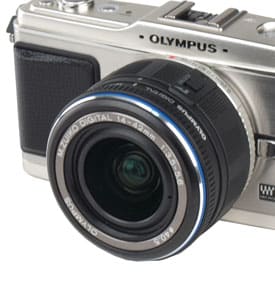
Connectivity
{{section_header}}{{section.name}}{{/section_header}}
Battery
{{section_header}}{{section.name}}{{/section_header}}
We love that the M40's battery cavity is so deep, allowing you to upgrade to a much larger battery without the annoyance of having your pack jut out from the back of the camcorder. The battery can be easily recharged by plugging the camcorder into a wall adapter. Since you can run the camcorder directly off the power cable, you can easily swap batteries without interrupting your recording.

Media
{{section_header}}{{section.name}}{{/section_header}}
The HF40 has an internal memory capacity of 16GB and is the primary differentiator between it and its sister models. The Canon HF M41 has 32GB of internal memory, while the HF M400 has no internal memory. All three models feature dual memory card slots, which are compatible with SD/SDHC/SDXC cards. The dual memory cards slots allow you to automatically record onto a second media source when your first source fills up: either from one card to the next or from the internal memory to a memory card. Read more about the advantages and disadvantages of various media types.

Conclusion
It turns out that Canon's gamble to put all new sensors into the 2011 consumer lineup has really paid off. The flagship HF G10 put up impressive numbers in low light performance—without much of a penalty to sharpness. For just $699.99 (MSRP), you can get virtually the same stellar performance in the Canon Vixia HF M40.
The HF M40 gets you a bit less in the way of manual controls, but there's still plenty to offer here. There's also a huge amount auto modes to ease the way for beginners... perhaps too many auto modes. In our opinion, that leaves the HF M40 just out of reach for the raw beginner. For experienced users looking to get the most for their money, the HF M40 is a sure thing.
Photo Gallery
{{photo_gallery "Front Photo", "Left Photo", "Left Open Photo", "Back Photo", "Right Photo", "Top Photo", "Bottom Photo", "Lens Photo", "Lens Photo 2", "3D Lens Photo", "Media Photo", "Easy Mode Photo", "Manual Controls Photo", "Zoom Photo", "Zoom Photo 2", "Ease of Use Photo", "Battery Photo", "LCD Photo 1", "LCD Photo 2", "EVF Photo 1", "EVF Photo 2", "Mic Photo", "Mic Photo 2", "Ports Photo 1", "Ports Photo 2", "Ports Photo 3", "Ports Photo 4", "Ports Photo 5", "Ports Photo 6", "Handling Photo 1", "Handling Photo 2", "Handling Photo 3", "Handling Photo 4", "Box Photo"}}
Meet the tester
Vice President of Editorial Management, Kaitlyn oversees the editorial departments of Reviewed.com’s various sites. She has been writing about technology since the turn of the century. Outside of her Reviewed.com home, Kaitlyn is also a theatre director and avid gamer.
Checking our work.
Our team is here to help you buy the best stuff and love what you own. Our writers, editors, and experts obsess over the products we cover to make sure you're confident and satisfied. Have a different opinion about something we recommend? Email us and we'll compare notes.
Shoot us an email